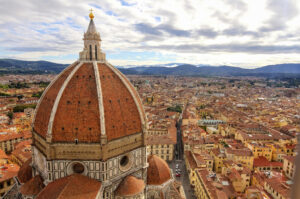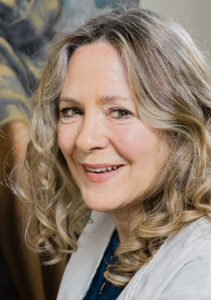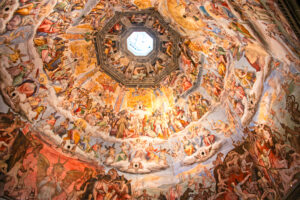At one time Florence was politically, economically and culturally one of the most important cities in Europe. Founded in a grid configuration in 59 B.C. as a colony for Roman soldiers, by the third century it evolved into a prospering provincial capital whose residents adopted a constitution restricting political power and developed a community of civil servants. By the 12th and 13th centuries, supported by the woolen textile industry and banks, it grew in economic power, with prominent families dominating international banking and merchant businesses.
By the middle of the 14th century Florence emerged as one of the greatest cities in Europe. Its golden coin, the florin, the first international currency, was the “dollar” of the Renaissance. After the Black Plague, the Medici family ascended to power, its princes underwriting Renaissance projects and dominating the region more or less until unification in the mid-19th century when, for a time, Florence was capital of the nascent Kingdom of Italy. Now absorbed into the peninsula nation, the “Flourishing City” is the commercial and cultural center of Tuscany.
With the world’s greatest concentration of art in proportion to its size, Florence is one of the most visited cities on the globe, with tourism the economy’s mainstay. Before the pandemic, Florence recorded 10–16 million visitors a year; in 2018 that figure ballooned to nearly 30 million travelers spending €3 billion on food, lodgings, shopping and attractions. Any year, April through October, local residents are outnumbered by tourists lining up to view the Duomo, sip Chianti in wine bars, lounge in the décor of Renaissance-inspired hotel rooms, gorge on creamy gelato and purchase finely crafted leather handbags.
A highly developed infrastructure supports the travel sector. Convenient air, rail and auto networks make the city accessible. Within town, tram and bus lines and e-bikes augment foot traffic in the historic center, which can be crossed on foot within a half hour. A flexible Florence City Pass allows admission and fast-track entry to many of the galleries, libraries, exhibits and 70 museums. Although depleted since the pandemic, statistics count trattorias, osterias, pizzerias, enotecas and 49 Michelin restaurants serving up pasta, pizza and the touted Florentine steak. While mid-range hotels remain most popular, in 2021 the city counted more than 400 hotels, including 3-star (215), 4-star (152) and 5-star (29) lodgings.

PHOTO: © SANDRO FILENI | DREAMSTIME .COM
Ongoing restoration and improvement projects continue to enhance the tourist experience. The Teatro Comunale transformed into a multifunctional music space and opera hall, while a former granary and army barracks has become a co-working hub. Manifattura Tabacchi, a disused tobacco factory, has been converted into a dynamic creative and fashion hub. Chic restaurants, residences and hotel rooms now occupy the historic Palazzo Portinari Salviati. Due to reopen is the restored Vasari Corridor, the kilometer-long enclosed passageway lined with paintings Cosimo 1 de’Medici built to allow private passage between his residence and the government palace.
Besides attracting sightseers, the tourism environment offers a desirable venue for meetings and conferences. Income resulting from annual fairs, theatrical productions, art exhibitions, festivals and fashion shows contributes significantly to the city’s budget. Restructured during the 1990s, the Fortezza da Basso Exhibition and Congress Centre provides more than 40,000 square feet of exhibition space and six meeting rooms.
But the 2-square-mile historical UNESCO city center lying within the remains of the 14th-century walls comprises barely 3 percent of Florence’s official 40-square-mile area. Outlying the Centro Storico, an important national production and commercial center houses facilities for General Electric, Philip Morris International, Ferrari, Nike, BASF, Siemens and Electrolux, among others. Suburban industrial complexes, factories and workshops produce furniture, chemicals, food and rubber goods, along with the traditional handicrafts, glassware, leatherwork, jewelry, souvenirs, metal and ironwork, shoes and fashion. Acknowledging production of high-quality goods, automobiles and the iconic Vespa scooter, the Pistoia-Prato Florence district has been dubbed the Third Italy.
Citing a per capita gross domestic product higher than national and European averages and a competitive cost of living, the public service agency Invest in Tuscany offers seven reasons to locate a business in “one of the most attractive and smart regions in Italy”: dynamic and diversified economy, talent pool, central location, local supportive government, competitive costs, key sectors and quality of life. Located halfway between Milan and Rome on three major highways, served by three airports and situated on high-speed rail lines, Florence’s strategic position provides a gateway to international markets.
To simplify entrepreneurial applications from potential and expanding businesses, a European Institute of Public Administration project in Tuscany streamlined interaction between enterprises and public requirements. Providing an “overview of the regional context and its opportunities,” Invest in Tuscany offers confidential guidance and support in all aspects of establishing businesses or planning equity investments to companies and startups. Life science, fashion, digital and ICT, yacht-building, logistics, agribusiness, tourism, smart industry, transport and mobility, and prestigious assets are listed as growth opportunities based on the region’s access to companies, universities and public institutions, and tradition.
International brands Salvatore Ferragamo, Emilio Pucci, Roberto Cavalli and Gucci are among local companies; and Italian haute couture, said to have originated here, benefits from a high concentration of institutes and academies dedicated to design, “Made in Italy” production districts, and a strategic chain of supplies. Past scientific breakthroughs of Leonardo da Vinci inspire local academia and research centers to transform visionary ideas and projects into digital and ICT products with strong commercial potential. The city and local institutes established a Science and Technology Foundation to integrate use of the region’s scientific heritage into current technology and modern communications. To encourage business incubation, the University of Florence implemented an investment policy which strengthens laboratories and equipment to support research aimed at technology transfer and innovation. Building on achievements of past glory days, Florence looks ahead to a prosperous commercial future.

PHOTO: © OLGA MAKAROVA
CHECKING IN WITH ELIZABETH WICKS
Painting and Art Restoration Master
As an expat who moved to Florence from the United States, what is it like to live there?
It’s very touristy, a bit like living in a fishbowl, but a wonderful place to live. People say there’s Florence, foreigners’ idea of what Florence is, and then there’s Firenze.
How do you deal with the tourist crowds?
For three years during COVID, people weren’t coming — then they all decided to come at once!! At the end of 2022, the number of tourists arriving just exploded. It’s so intense, there’s going to be a new law curbing how many new Airbnb rentals can open.
How do you feel you are part of the city?
I’m president of an association of women expats. Our current mayor is sensitive to the foreign population, and we have a voice in the city, which is nice. We come to live and work here.
How does a newcomer fit in?
It’s welcoming, a culturally full place with lots to do, schools, groups you can join and get involved. Florence has lots of expats and a big Anglo presence, ever since the 19th-century Grand Tour. English is prevalent. If you want to really get away and experience a different culture, you would choose another place.
What are the realities of relocating?
There are lots of logistics. Starting a business or buying property is not as streamlined as Americans might be used to. Getting business done day to day might prove frustrating to Americans used to a smooth line. “Patience” is one of the first words I learned when I got here. You have to be flexible. The American Consulate and the Chamber of Commerce here are very helpful.
What business opportunities do you see?
Of course, there’s fashion, tourism, the arts. We’re lacking in the logistics: supply chain, moving merchandise, foreign investment

PHOTO: © LUCIANO MORTULA | DREAMSTIME
DIVERSIONS
The Renaissance icons are must-sees — the Duomo, Uffizi Gallery, the David statue, Ponte Vecchio — though expect long lines. You’ll encounter shorter lines at the Pitti Palace and the National Museum of Bargello. Stop by Casa Buonarroti, Michaelangelo’s house museum, and gaze up at the recently restored L’Allegoria dell’inclinazione painted in 1616 by renowned Renaissance female artist Artemisia Gentileschi.
For ambience, everything takes place outdoors in sidewalk cafés and gardens. Florence is a great place to wander and watch the beautiful people. Order a glass of Chianti at the garden bar in Serre Torrigiani. Cross the river to trendy Oltrarno, the artists’ quarter; stroll through The Boboli Gardens; and stray from one café to another during aperitivo hour. No building in Florence is allowed to be taller than the Duomo; get a spectacular view of the cathedral from the Caffé degli Innocenti in the Brunelleschi Foundling Hospital, where visitors join locals for a breakfast cup of coffee.
LODGING
Four Seasons Hotel Firenze
On the grounds of the city’s largest private garden, walled with an outdoor swimming pool, the historic hotel with fountains, statues and fresco-lined walls attracts both visitors and Florentine residents who favor its afternoon tea.
Borgo Pinti 99, Florence
$$$$$
Helvetia & Bristol Firenze
Mere steps away from the city’s main sights, this iconic grande dame, recently restored, showcases classic Florentine craftsmanship and features a spa with ruins of Roman thermal baths visible through the glass-bottomed swimming pool.
Via dei Pescioni 2, Florence
$$$$$
Villa San Michele
Renaissance meets contemporary in this 16th-century monastery. On a city hilltop surrounded by gardens, this Belmond hotel offers spectacular skyline views from arched stone terraces and exquisite guestrooms, suites and villas.
Via Doccia 4, Fiesole, Florence
$$$$$
DINING
Atto Di Vito Mollica
In the smart 15th-century Palazzo Portinari Salviati hotel, the chic, sophisticated, updated classic fare earned a Michelin star for celebrated chef Vito Mollica.
Via del Corso 6, Florence $$$$$
Le Volpi e l’uva
Cheeses, cured meats and breads from small specialty producers complement local and native wines collected from every region of Italy in this popular wine bar.
Piazza dei Rossi 1, Florence
$$$
Trattoria Cammillo
Woodfire-grilled Fiorentina steak, wild boar pappardelle and the specialty thick bread soup shine among staples served on freshly pressed linens in this atmospheric classic.
Borgo S. Jacopo 57/r, Florence
$$$
OFFICIAL LANGUAGE
Italian
COMING AND GOING
U.S. citizens must have a passport valid for at least three months after planned departure, with at least two blank pages for stamps. After November 2023 American citizens will be required to apply online for the ETIAS visa waver proving adequate funds. Proof of health insurance is recommended.
JUST THE FACTS
Time zone: GMT+1
Phone code: Country code: 39 City Code: 55
Currency: Euro
Key industries: Tourism, financial services, environmental technology, manufacturing, trading and logistics
INFO TO GO
Florence Airport Peretola (Amerigo Vespucci Airport ) lies 7 miles from the city. Arriving visitors can find the taxi stand just outside of the arrivals terminal; official taxis are white or yellow with a “taxi” sign on the top of the car. Car rentals are also available. Florence Santa Maria Novella train station serves as a central Italy hub for rail connec- tions to other cities.
Read This Next

Introducing
FX Excursions
FX Excursions offers the chance for once-in-a-lifetime experiences in destinations around the world.
#globility
Insta FeedDaily
May 8, 20255 Destinations for a Fourth of July Getaway
Get a jumpstart on Fourth of July travel plans and book a trip to one of these patriotic destinations.
Sponsored Content
Find Your Perfect Escape with Paradisus by Meliá — More Than Just All-Inclusive
Luxury travel today is about more than just beautiful accommodations — it’s about experiencing the destination. Paradisus by Meliá takes traditional all-inclusive resorts to the next level by offering indulgence with immersion, experiences and authenticity. Each resort is shaped by its location, local flavors and curated Destination Inclusive® experiences that bring you closer to the heart of the destination.
Daily
May 8, 2025New Taipei City Art Museum Opens
After years of preparation, New Taipei City’s first public art museum, New Taipei City Art Museum, opened at the end of April. Positioned as a public art museum, NTCAM aims to become more than just a cultural landmark by seeking to actively engage with citizens, international visitors, artists and the broader community in Taiwan through dialogue and collaborative projects.
Daily
May 8, 2025Fort Lauderdale Hosts Third Annual Sports Fishing Competition: The Catch
The third edition of Sports Fishing Competition’s The Catch, powered by Verizon, returned to Fort Lauderdale’s scenic marina this past April, bringing current and former professional football players together to compete in an offshore fishing pro-am against 16 professional SFC angling clubs and competitors.
Sponsored Content
Royal Air Maroc Introduces Groundbreaking Safety Video: A Captivating Invitation to Discover Moroccan Heritage
Royal Air Maroc continues to elevate the passenger experience with the launch of its new in-flight safety video — a cinematic journey that seamlessly blends essential safety instructions with a celebration of Moroccan cultural heritage.
Daily
May 7, 2025Welcome Spring with The Ritz-Carlton New York, Central Park’s Picnic in the Park
There’s a lovely alchemy that takes place when you mix sunshine and a leafy park. Add a picnic basket full of goodies and you’re on your way to a memorable outdoor escape. At The Ritz-Carlton New York, Central Park, guests can embrace springtime in the city with a gourmet picnic-to-go lunch in Central Park, featuring fresh fare thoughtfully curated by Executive Chef Andrew Burriesci.
ZURiTO Review
eFlyer Reviews
May 7, 2025eFlyer Deals
May 7, 2025Book This New Girls Getaway Offer from Sheraton Kauai Coconut Beach Resort
This summer, take a girls’ trip to Hawai’i, save big and experience unforgettable moments. Sheraton Kauai Coconut Beach Resort debuted a new Girls Just Want to Have Fun promotion.
Sponsored Content
Royal Air Maroc Marks Five Years with oneworld: Strengthening Connectivity Between USA and Africa and Expanding Global Reach
Royal Air Maroc proudly enters its fifth year as a member of the prestigious oneworld alliance. Since joining in April 2020, RAM has demonstrated resilience during the COVID-19 pandemic, emerging as a dynamic airline that enhanced its digital services and expanded its network. The airline plans to grow its fleet to 200 aircraft by 2037, reinforcing its global presence.
eFlyer Deals
May 7, 2025Mexico Grand Hotels Extends Cinco de Mayo with Limited-Time Promotion
Cinco de Mayo may be over, but that doesn’t mean the celebrations have ended. Mexico Grand Hotels extends the festivities of the Mexican holiday with its 5 de Mayo sale.
ShareThis